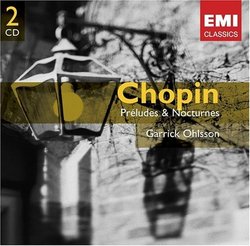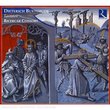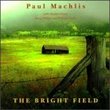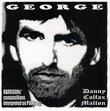| All Artists: Frederic Chopin, Garrick Ohlsson Title: Chopin: Préludes & Nocturnes Members Wishing: 0 Total Copies: 0 Label: EMI Classics Release Date: 5/24/2005 Genre: Classical Styles: Chamber Music, Historical Periods, Classical (c.1770-1830) Number of Discs: 2 SwapaCD Credits: 2 UPC: 724358650723 |
Search - Frederic Chopin, Garrick Ohlsson :: Chopin: Préludes & Nocturnes
 | Frederic Chopin, Garrick Ohlsson Chopin: Préludes & Nocturnes Genre: Classical
|
Larger Image |
CD DetailsSimilar CDs
|
CD ReviewsHighly Recommendable First Ohlsson Versions C. Pontus T. | SE/Asia | 10/11/2008 (4 out of 5 stars) "Four years after his Warsaw triumph, Garrick Ohlsson recorded his first complete set of Chopin Preludes for EMI. Acknowledging it is not quite up to the level of mastery he attained some 15 years later in his reference complete Chopin survey for Arabesque Recordings, it still stands out as one of the more successful Op 28 Preludes renditions. Starting off a bit square in the first seven Preludes (the A minor being unusually tedious), things really take wing in the F-sharp minor (in fact slightly preferable in passion to the remake); the F-sharp major, D-flat major and A-flat major more than only hint at the celestial beauty of the 1989 remakes; the C-sharp minor, E-flat minor, B-flat minor, F minor, G minor and D minor Preludes more than hold their own against vastly more celebrated versions. If there is something in particular to treasure with this generously inexpensive twofer, it has been neatly summarised by the Loves Music reviewer as 'beautiful performances [...] in a straightforward manner'. Perhaps, this is even more true for Ohlsson's first complete 1977-9 Nocturnes survey. Even if not being as deeply searching and endlessly beautiful as the 1994 remake, his first survey gets quite far--indeed a great deal farther than such ridiculously overrated versions as Pires and Pollini. There are some rather marvelous performances to be pointed out: a sparkling Op 9/3, a masterly Op 27/1, true bel canto Op 48/2, a benchmark Op 55/2 (this tricky polyphonic masterpiece is an Ohlsson specialty, only bettered in his 1994 remake), and a gorgeous Op 62/1. Less successful are the rushed Op 27/2, the slightly monotonous Opp 32 & 37, whereas Op 48/1 is rushed and forced completely out of shape (though, his remake of this masterpiece more than makes up for this initial failure). The Preludes are recorded on a Steinway to normally good Abbey Road standards, whereas the Nocturnes are played on a Bösendorfer. Many labels have attempted to record Bösendorfer grands, unfortunately seldom with complete success--Ohlsson's complete Chopin cycle on Arabesque Recordings being the outstanding exception. This EMI attempt succeeds reasonably well in the areas of balance and naturalness, though failing in terms of atmosphere and brilliance. Consequently, at less than $10, this 2-CD is highly recommendable--although, irrespective of price, the Arabesque remakes are indispensable (Garrick Ohlsson: The Complete Chopin Piano Works Vol. 2 - Preludes, Garrick Ohlsson - The Complete Chopin Piano Works Vol. 6 ~ Nocturnes)." Ohlsson is very assured, but too much poetry is turned to pr Santa Fe Listener | Santa Fe, NM USA | 04/19/2009 (3 out of 5 stars) "Two of the five-star reviewers use "striaghtforward" as a term of praise for Garrick Ohlsson's style in Chopin. For me, straightforward isn't praise. Ohlsson's interpretations are prosaic and at times ordinary. The first seven Preludes lack any poetry -- even one of his supporters recognizes that they are tedious -- but it's not as if the remaining Preludes suddenly rise to another league altogether. Ohlsson is a Chopin specialist of an odd sort, in that he takes pains not to shape the lne with tenderness, melanchily, or Romantic longing. Here is Chopin turned into a healthy, middle-class kind of guy, which appeals to some listeners, I suppose. Presumably those who also praise conductors who "let the music speak for itself." After winning the Warsaw Chopin competition in 1970, Ohlsson began a career on any number of labels (Connoisseur Society, EMI, Arabesque, et al.), so these early recitals don't represent a summaiton of his art. But having encountered him off and on since the Seventies, my impression has remained of a pianist who disavows temperament, inwardness, and affectation, whhich plays for both good and ill. I find his style rather faceless and blunt, but others hear a refresshing directness and sincerity. He never simpers, but he doesn't cast a spell, either. In the Nocturnes, which too often are subjected to fussiness and over-done rubato, I liked Ohlsson better. His forthrightness brought out more structure and shape than usual, and each Nocturne sang a simpler song than I hear from Pires, Rubenstein, Moravec, or Pollini. Still, once you've been pulled into the expressive world of a Pollini, Argerich, Kissin, Richter Pletnev, Zimerman, or the newest prodigy from Poland, Rafal Blechacz, Ohlsson's Chopin can seem rather plain Jane, despite his assurance and technical craft. " Loud and thick and otherwise monotonous J. Renouf | 08/21/2009 (2 out of 5 stars) "I bought these discs to listen to the preludes, so I will limit my comments to those. Approximately 80 years later, Alfred Cortot's version of these miniature musical gems remains the standard (although they are assuredly not without their flaws). This disc is further confirmation of the utter colorlessness and vapidness of modern piano playing. Though not as rhythmically and dynamically pallid or senselessly brusque as Pollini's and Argerich's versions, respectively, Ohlsson's playing brings crudity to a whole new level. As another reviewer pointed out, some of the commenters on here ludicrously used adjectives such as "workman-like" to describe the playing in a positive light. I do certainly agree with that usage. It's a bit of an understatement though. I would rather describe his playing as "oafish" and "clunky." To me, his playing of these pieces is reminiscent of a hippopotamus trodding on a violet patch. The main problem is the utter disregard for pianistic balance and texture. Here are some specifics:
#1: Where's the melody? This is the main point of the piece, both technically and musically. The passionate, palpitating figure, played by the thumb, should soar out above the accompanying musical texture in the right hand. Here it's timid and rather monotonal, and the double-note accompanimental figurations at the top of the same hand are actually louder in places. #2 Slow to the point of ridiculousness. Also, he gives a rather strange hesitation to the appoggiatura in the righthand melody. Whatever way this is played, it should flow and not hiccup. #3 At least his left hand is clear (unlike Pollini's rendition, which I remember as being a bit syrupy and smeared), but that's all he's focusing on. From a listener's perspective, the right hand melody, again the point of the piece, is practically nonexistent. There's no grace or rythmic freedom, exacerbated by a total lack of pedal, which I think should at least be on the opening quaver of each measure. #4, 6, and 7: Marred by an utter lack of phrasing as well as some of the most rhythmically monotonous playing I have ever heard. Obviously, these are some of the least difficult technically of the set, yet they are seldom played in an interesting way, and these are easily some of the most boring renditions out there. Either he's scared to use rubato for fear of not knowing what to do with it or he doesn't possess a wit of imagination -- I suspect a combination of both. #5: Where's the dynamics? He goes from forte to fortissimo at the end but doesn't get any of the crescendos that Chopin marked out of the theme or its repeat. In addition, the opening melody, so ethereal and springlike, is barely audible. #8: This, in my opinion the greatest of the preludes, has some of the same problems with balance as number 1 (he only really brings the melody out in the forte sections), but at least he does something with the overall gesture. This is the only prelude where he seems to have a plan for the structure of the piece and at least works up to a crescendo, albeit a rather crude and obvious one. The small accompanimental figures, however, are rather too loud and unclear. #12: Skipping ahead a bit, this is crude playing even compared with some of the rest of them. Yes, it's marked forte at the outset, but dynamics are relatives and when he gets to the fortissimo on the second page, he has nowhere to go dynamically (a common problem, it seems, with much modern piano playing). The way it should probably be interpreted is, as Chopin marked it accentwise, that the forte goes on the initial accent and then the accomanying notes are piano. That would give technical control and not sound so klutzy. In Cortot's hands this sounds as I think it should, as the horses galloping on a midnight ride. In his hands, it sounds to me rather like stampeding elephants frantically trying to escape from poachers. #16: The opening bars, marked with sforzato accents, are overemphasized. They should have point and bite but not sound like hammers pounding the piano keys into submission. The touch is heavy and crude. Then, when the presto con fuoco gets going, there is hardly any dynamic contrast and it is too loud and overly fussy (albeit dynamics are very difficult to focus on in this technically hairy prelude), except, ironically, in what many pianists find to be the most difficult passage in the modulatory fingerwork on the third page. #19: At least the sound's not so crude (perhaps he is using some soft pedal here?), but he moons over the phrases a bit; they never soar or take flight. #22: I've never heard such crude octave playing. Where they should be played from the wrist, it sounds like he's using his hand, his arm, maybe even the whole left lateral side of his body, to play them. Also, some very strange and uneven-sounding rests and accents. #24: If I were in the audience listening to this, I would almost feel like shouting out, "Dude, the left hand's an accompaniment!" The tempo, in this, perhaps the most dramatic and martial of the Chopin preludes, is overly careful, uneven (especially in sound), and loud, and again, the melody in the right hand does nothing. How could it when the left hand is so pounded? If you're going to play this as it should sound (e.g., Cortot and Richter), you're probably going to miss a few notes, and that's just fine by me. To sum up, this assuredly is contest-winning playing: reliable, accurate, loud, obvious. Well, he may have won the Chopin competition, but in my book he's no artist and has no real technique in the old school sense, where it was always tied to freedom, tone production, clarity, etc. (how anyone can say that technique is right notes is beyond me). All I can admire here is that he got through these pieces and got most of the notes (although he dropped a few anyway in some of the more difficult passages). Big deal; we should expect more from a professional pianist. I always bemoan the fact that listeners often seem to like this sort of thing simply because it's the only thing they've been exposed to. Besides Cortot, there's so much else out there that at least is good: try complete sets of Sofronitzky, Jeanne-Marie Darre, or individual performances of Friedman, Cherkassky, or even Richter, among others, and hear the difference. " |

 Track Listings (33) - Disc #1
Track Listings (33) - Disc #1


